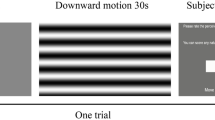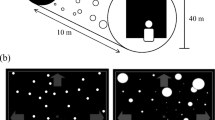Abstract
The dependency of the N200 amplitude of the motion-onset VEP evoked by a parafoveal grating of variable speed (0.25 – 13.5 deg/s, corresponding to 0.5 – 27 Hz) and constant contrast (4%) was studied. Additional measurements were made with parafoveally presented gratings of constant speed (2 deg/s, corresponding to 4 Hz) and a variable contrast (0.5 – 64%) before and after adaptation to a stationary or drifting grating. In this latter experiment, simultaneous psychophysical measurements were made of the perceived speed. The amplitude of the N200 wave increased with increasing stimulus speed within the slow speed range up to 1.5 deg/s (corresponding to 3 Hz). Adaptation to a stationary grating had no significant effect on the relationship between the N200 amplitude and stimulus contrast. Contrary to this, adaptation to a slowly drifting grating (1 deg/s, corresponding to 2 Hz) or to a rapidly drifting grating (4 deg/s, corresponding to 8 Hz) reduced the N200 amplitude significantly. Adaptation to a stationary grating slightly reduced the perceived speed of subsequently viewed gratings. Adaptation to a slowly drifting grating increased the perceived speed of the subsequently viewed gratings, whereas adaptation to a rapidly drifting grating decreased the perceived speed. The findings can be best explained by a two-channel model of speed perception. While the motion VEP reflects the sum of both channel activities, the psychophysical measures point to the antagonistic encoding of low and high velocities.
Similar content being viewed by others
References
Göpfert E, Müller R, Markwardt F, Schlykowa L. Visuell evozierte Potentiale bei Musterbewegung. Z EEG-EMG 1983; 14: 47–51.
Blakemore C, Campbell FW. On the existence of neurons in the human visual system selectively sensitive to the orientation and size of retinal images. J Physiol (London) 1969; 203: 237–260.
Müller R, Greenlee MW. Effect of contrast and adaptation on the perception of the direction and speed of drifting gratings. Vision Res 1994; 34: 2071–2092.
Thompson P. Velocity after-effects: The effects of adaptation to moving stimuli on the perception of subsequently seen moving stimuli. Vision Res 1981; 21: 337–345.
Thompson P. The coding of velocity of movement in the human visual system. Vision Res 1984; 24: 41–45.
Anderson SJ, Burr DC. Spatial and temporal selectivity of the human motion detection system. Vision Res 1985; 25: 1147–1154.
Hess RF, Snowden RJ. Temporal properties of human visual filters: number, shapes and spatial covariation. Vision Res 1992; 32: 47–59.
Smith AT, Edgar GK. Antagonistic comparison of temporal frequency filter outputs as a basis for speed perception. Vision Res 1994; 34: 253–265.
Hess RF, Bex PJ, Fredericksen ER, Brady N. Is human motion detection subserved by a single or muliple channel mechanism? Vision Res 1998; 38: 259–266.
Müller R, Göpfert E, Hartwig M. VEP-Untersuchungen zur Kodierung der Geschwindigkeit bewegter Streifenmuster im Kortex des Menschen. Z EEG-EMG 1985; 16: 75–80.
Müller R, Göpfert E, Hartwig M. The effect of movement adaptation on human cortical potentials evoked by pattern movement. Acta Neurobiol Exp 1986; 46: 293–301.
Foster KH, Gaska JP, Nagler M, Pollen DA. Spatial and temporal frequency selectivity of neurons in visual cortical areas Vl and V2 of the macaque monkey. J Physiol (London) 1985; 365: 331–363.
Gegenfurtner KR, Kiper DC, Levitt JB. Functional properties of neurons in macaque area V3. J Neurophysiol 1997; 77: 1906–1923.
Lagae L, Raiguel S, Orban GA. Speed and direction selectivity of macaque middle temporal neurons. J Neurophysiol 1993; 69: 19–39.
Bach M, Ullrich D. Motion adaptation governs the shape of motion-evoked cortical potentials. Vision Res 1994; 34: 1541–1547.
Dorn TJ, Hoffmann M, Bach M. Motion adaptation time constants of the motion-onset VEP. Invest Ophthal and Visual Science 1997; 38: S992.
Rovamo J, Virsu V. An estimation and application of the human cortical magnification factor. Exp Brain Res 1979; 37: 495–510.
Lieberman H, Pentland AP. Microcomputer-based estimation of psychophysical thresholds: the best PEST. Behavior Research Methods Instruments and Computers 1982; 14: 21–25.
Tootell RBH, Mendola JD, Hadjikhani NK, Liu AK, Dale AM. The representation of the ipsilateral visual field in human cerebral cortex. Proc Natl Acad Sci USA 1998; 95: 818–824.
Chen Y, Bedell HE, Frishman LJ. Velocity discrimination between stimuli of different spatial frequencies. Invest Ophthal and Visual Science 1995; 36: S54.
Yo C, Wilson HR. Peripheral temporal frequency channels code frequency and speed inaccurately but allow accurate discrimination. Vision Res 1993; 33: 33–45.
Kubova Z, Kuba M, Spekreijse H, Blakemore C. Contrast dependence of motion-onset and pattern-reversal evoked potentials. Vision Res 1995; 35: 197–205.
Bach M, Ullrich D. Contrast dependency of motion-onset and pattern-reversal VEPs: Interaction of stimulus type, recording site and response component. Vision Res 1997; 37: 1845–1849.
Tootell RBH, Reppas JB, Kwong KK, Malach R, Born RT, Brady TJ, Rosen BR, Belliveau JW. Functional analysis of human MT and related visual cortical areas using magnetic resonance imaging. J Neurosci 1995; 15: 3215–30.
Thompson P. Perceived rate of movement depends on contrast. Vision Res 1982; 22: 377–380.
Stone LS, Thompson P. Human speed perception is contrast dependent. Vision Res; 32: 1535–1549.
Author information
Authors and Affiliations
Rights and permissions
About this article
Cite this article
Müller, R., Göpfert, E., Breuer, D. et al. Motion VEPs with simultaneous measurement of perceived velocity. Doc Ophthalmol 97, 121–134 (1998). https://doi.org/10.1023/A:1002007132500
Issue Date:
DOI: https://doi.org/10.1023/A:1002007132500




